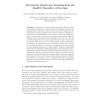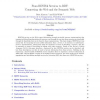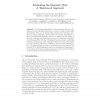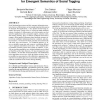186 search results - page 3 / 38 » Learning to Harvest Information for the Semantic Web |
GEOS
2009
Springer
13 years 10 months ago
2009
Springer
As directories of named places, gazetteers link the names to geographic footprints and place types. Most existing gazetteers are managed strictly top-down: entries can only be adde...
CORR
2010
Springer
13 years 6 months ago
2010
Springer
RESTful services on the Web expose information through retrievable resource representations that represent self-describing descriptions of resources, and through the way how these...
SEMWEB
2007
Springer
14 years 8 days ago
2007
Springer
The increased availability of online knowledge has led to the design of several algorithms that solve a variety of tasks by harvesting the Semantic Web, i.e., by dynamically select...
BXML
2003
13 years 7 months ago
2003
Abstract: The goal of information extraction (IE) is to find desired pieces of information in natural language texts and store them in a form that is suitable for automatic queryi...
WWW
2009
ACM
14 years 6 months ago
2009
ACM
Social bookmarking systems and their emergent information structures, known as folksonomies, are increasingly important data sources for Semantic Web applications. A key question ...




